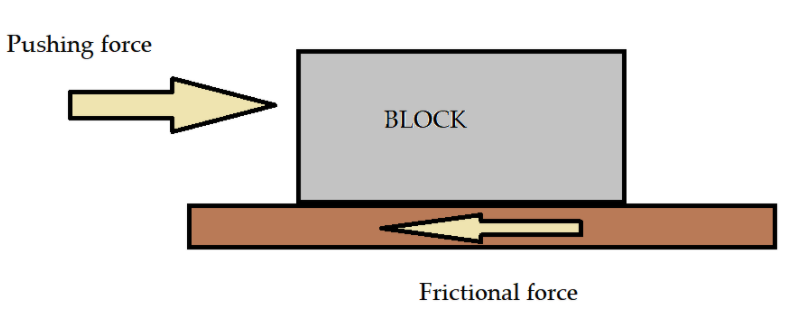
Define Friction.
Answer
551.1k+ views
Hint: Friction is a type of relative force that acts as a resistance between two bodies that are in contact with each other. In other words when two bodies are in contact with each other there exists a force which opposes their relative motion. Friction is not a fundamental force like electromagnetism and gravitational force.
Complete step by step answer:
As discussed friction is a type of force that occurs between two surfaces that can slide over each other. The frictional force is a resistance that occurs between two surfaces that are in contact and when they slide over each other hence their relative motion gets affected.

Friction is governed by some laws.
• Friction generally depends on the roughness and hardness of the surface of the contact.
• Friction is proportional directly to the normal force.
• Friction is independent of the area of the contacting surfaces.
There are several types of friction that vary from object to object. Generally, there are four main types of friction. They are static friction, sliding friction, fluid friction, rolling friction. In brief, the static friction exists between a stationary object and on the surface where it rests. While sliding force occurs between two objects that are sliding over each other. Fluid friction generally causes a resistance on the object due to water and air. Rolling friction occurs on an object such as balls and wheels.
Note: Friction can be observed in our day-to-day life as it is a very applicable force also. To stop moving when brakes are applied then it stops due to the friction between tyres and brakes. Similarly, because the static friction book kept on the desk doesn't fall easily.
Complete step by step answer:
As discussed friction is a type of force that occurs between two surfaces that can slide over each other. The frictional force is a resistance that occurs between two surfaces that are in contact and when they slide over each other hence their relative motion gets affected.

Friction is governed by some laws.
• Friction generally depends on the roughness and hardness of the surface of the contact.
• Friction is proportional directly to the normal force.
• Friction is independent of the area of the contacting surfaces.
There are several types of friction that vary from object to object. Generally, there are four main types of friction. They are static friction, sliding friction, fluid friction, rolling friction. In brief, the static friction exists between a stationary object and on the surface where it rests. While sliding force occurs between two objects that are sliding over each other. Fluid friction generally causes a resistance on the object due to water and air. Rolling friction occurs on an object such as balls and wheels.
Note: Friction can be observed in our day-to-day life as it is a very applicable force also. To stop moving when brakes are applied then it stops due to the friction between tyres and brakes. Similarly, because the static friction book kept on the desk doesn't fall easily.
Recently Updated Pages
Why are manures considered better than fertilizers class 11 biology CBSE

Find the coordinates of the midpoint of the line segment class 11 maths CBSE

Distinguish between static friction limiting friction class 11 physics CBSE

The Chairman of the constituent Assembly was A Jawaharlal class 11 social science CBSE

The first National Commission on Labour NCL submitted class 11 social science CBSE

Number of all subshell of n + l 7 is A 4 B 5 C 6 D class 11 chemistry CBSE

Trending doubts
What is meant by exothermic and endothermic reactions class 11 chemistry CBSE

1 Quintal is equal to a 110 kg b 10 kg c 100kg d 1000 class 11 physics CBSE

What are Quantum numbers Explain the quantum number class 11 chemistry CBSE

What is periodicity class 11 chemistry CBSE

What is a periderm How does periderm formation take class 11 biology CBSE

Mention the basic forces in nature class 11 physics CBSE




